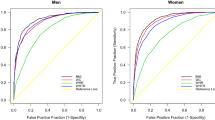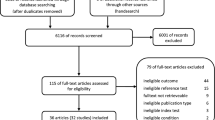Abstract
Current classifications of obesity based on body mass index, waist circumference and other anthropometric measures, although useful for population studies, have important limitations when applied to individuals in clinical practice. Thus, these measures do not provide information on presence or extent of comorbidities or functional limitations that would guide decision making in individuals. In this paper we review historical and current classification systems for obesity and propose a new simple clinical and functional staging system that allows clinicians to describe the morbidity and functional limitations associated with excess weight. It is anticipated that this system, when used together with the present anthropometric classification, will provide a simple framework to aid decision making in clinical practice.
This is a preview of subscription content, access via your institution
Access options
Subscribe to this journal
Receive 12 print issues and online access
$259.00 per year
only $21.58 per issue
Buy this article
- Purchase on Springer Link
- Instant access to full article PDF
Prices may be subject to local taxes which are calculated during checkout
Similar content being viewed by others
References
Seidell JC . Epidemiology of obesity. Semin Vasc Med 2005; 5: 3–14.
Unger RH . Lipotoxic disease. Annu Rev Med 2002; 53: 319–336.
Haslam DW, James WPT . Obesity. Lancet 2005; 366: 1197–1209.
Flegal KM, Graubard BI, Williamson DF, Gail MH . Cause-specific excess deaths associated with underweight, overweight, and obesity. JAMA 2007; 298: 2028–2037.
Pischon T, Boeing H, Hoffmann K, Bergmann M, Schulze MB, Overvad K et al. General and abdominal adiposity and risk of death in Europe. N Engl J Med 2008; 359: 2105–2120.
Sui X, LaMonte MJ, Laditka JN, Hardin JW, Chase N, Hooker SP et al. Cardiorespiratory fitness and adiposity as mortality predictors in older adults. JAMA 2007; 298: 2507–2516.
Bray GA . Definition, measurement, and classification of the syndromes of obesity. Int J Obes 1978; 2: 99–112.
Callaway CW, Greenwood MRC . Introduction to the workshop on methods for characterizing human obesity. Int J Obes 1984; 8: 477–480.
Bray GA . Obesity: historical development of scientific and cultural ideas. Int J Obes 1990; 14: 909–926.
Puhl R, Brownell KD . Bias, discrimination, and obesity. Obes Res 2001; 9: 788–805.
Scott HW, Law DH, Sandstead HH, Lanier VC, Younger RK . Jejunoileal shunt in surgical treatment of morbid obesity. Ann Surg 1970; 171: 770–782.
Scott WH, Law DH . Clinical appraisal of jejunoileal shunt in patients with morbid obesity. Am J Surg 1969; 117: 246–253.
International Classification of Diseases. www.icd9data.com.
Sjostrom L, Bjorntorp P . Body composition and adipose tissue cellularity in human obesity. Acta Med Scand 1974; 195: 201–211.
Vague J . Obesities. John Libbey and Co.: London, England, 1991.
Janssen I, Katzmarzyk PT, Ross R . Waist circumference and not body mass index explains obesity-related health risk. Am J Clin Nutr 2004; 79: 379–384.
Yusuf S, Hawken S, Ounpou S, Bautista L, Franzosi MG, Commerford P et al. Obesity and the risk of myocardial infarction in 27 000 participants from 52 countries: a case-control study. Lancet 2005; 366: 1640–1649.
Zhang C, Rexrode KM, van Dam RM, Li TY, Hu FB . Abdominal obesity and the risk of all-cause, cardiovascular, and cancer mortality. Sixteen years of follow-up in US women. Circulation 2008; 117: 1658–1667.
Klein S, Allison DB, Heymsfield SB, Kelly DE, Leibel RL, Nonas C et al. Waist circumference and cardiometabolic risk: a consensus statement from shaping America's health: Association for Weight Management and Obesity Prevention; NAASO, The Obesity Society; the American Society for Nutrition; and the American Diabetes Association. Obesity 2007; 15: 1061–1067.
World Health Organization. International Classification of Diseases (ICD). www.who.int/classifications/icd/en/ (Accessed May 22, 2008).
Jebb SA, Elia M . Techniques for the measurement of body composition: a practical guide. Int J Obes 1993; 17: 611–621.
Weigley ES . Average? Ideal? Desirable? A brief overview of height-weight tables in the United States. J Am Diet Assoc 1984; 84: 417–423.
National Institutes of Health Consensus Development Conference Statement. Health implications of obesity. Ann Intern Med 1985; 103: 1073–1077.
Keys A, Fidanza F, Karvonen K, Chimarera N, Tayor HL . Indices of relative weight and obesity. J Chronic Dis 1972; 25: 239–343.
Calle EE, Thun MJ, Petrelli JM, Rodriguez C, Heath CW . Body-mass index and mortality in a prospective cohort of U.S. adults. N Engl J Med 1999; 341: 1097–1105.
Romero-Corral A, Montori VM, Somers VK, Korinek J, Thomas RJ, Allison TG et al. Association of bodyweight with total mortality and with cardiovascular events in coronary artery disease: a systematic review of cohort studies. Lancet 2006; 368: 666–678.
World Health Organization. Report of a WHO consultation on obesity. Obesity: preventing and managing the global epidemic. World Health Organization: Geneva, 1998.
NHLBI Obesity education initiative expert panel on the identification, evaluation, and treatment of overweight and obesity in adults. Clinical guidelines on the identification, evaluation, and treatment of overweight and obesity in adults—the evidence report. Obes Res 1998; 6: 51S–209S.
Kuczmarski RJ, Carroll MD, Flegal KM, Troiano RP . Varying body mass index index cutoff points to describe overweight prevalence among US adults. NHANES III (1988–1994). Obes Res 1997; 5: 542–548.
Kuczmarski RJ, Flegal KM . Criteria for definition of overweight in transition: background and recommendations for the United States. Am J Clin Nutr 2000; 72: 1074–1081.
Scottish Intercollegiate Guidelines Network. Obesity in Scotland. Integrating prevention with weight management. A national clinical guideline recommended for use in Scotland. Scottish Intercollegiate Guidelines Network (SIGN): Edinburgh, Scotland. Pilot edn. 1996.
Lau DCW, Douketis JD, Morrison KM, Hramiak IM, Sharma AM, Ur E, Obesity Canada Clinical Practice Guidelines Expert Panel. 2006 Canadian clinical practice guidelines on the management and prevention of obesity in adults and children [summary]. CMAJ 2007; 176 (8 suppl): S1–S13.
Clinical Guideline 43 Obesity: guidance on the prevention, identification, assessment and management of overweight and obesity in adults and children. National Institute of Health and Clinical Excellence (NICE): London, UK, 2006.
Third report of the national cholesterol education program (NCEP) expert panel on detection, evaluation, and treatment of high blood cholesterol in adults (Adult treatment panel III). Final report. National Heart, Lung, and Blood Institute, National Institutes of Health, NIH publication No. 02-5215, September 2002.
WHO Expert Consultation. Appropriate body-mass index for Asian populations and its implications for policy and intervention strategies. Lancet 2004; 363: 157–163.
Razak F, Anand SS, Shannon H, Vuksan V, Davis B, Jacobs R et al., The SHARE Investigators. Defining obesity cut points in a multiethnic population. Circulation 2007; 115: 2111–2118.
Lean MEJ, Han TS, Deurenberg P . Predicting body composition by densitometry from simple anthropometric measurements. Am J Clin Nutr 1996; 63: 4–14.
Rankinen T, Kim SY, Pérusse L, Després JP, Bouchard C . The prediction of abdominal visceral fat level from body composition and anthropometry: ROC analysis. Int J Obes Relat Metab Disord 1999; 23: 801–809.
Wellens RI, Roche AF, Khamis HJ, Jackson AS, Pollock ML, Siervogel RM . Relationships between body mass index and body composition. Obes Res 1996; 4: 35–44.
Gallagher D, Heymsfield SB, Heo M, Jebb SA, Murgatroyd PR, Sakamoto Y . Healthy percentage body fat ranges: an approach for developing guidelines based on body mass index. Am J Clin Nutr 2000; 72: 694–701.
Wilson PW, D’Agostino RB, Levy D, Belanger AM, Silbershatz H, Kannel WB . Prediction of coronary heart disease using risk factor categories. Circulation 1998; 97: 1837–1847.
US Preventive Services Task Force. Screening for obesity in adults: recommendations and rationale. Ann Intern Med 2003; 139: 930–932.
US Department of Health Services Agency for Healthcare Research and Quality (AHRQ). www.ahrq.gov/clinic/ppipx.htm (Accessed May 22, 2008).
Little P . GP documentation of obesity: what does it achieve? Br J Gen Practice 1998; 48: 890–894.
McArtor RE, Iverson DC, Benken D, Dennis LK . Family practice residents’ identification and management of obesity. Int J Obes Relat Metab Disord 1992; 16: 335–340.
Himmel W, Stolpe C, Kochen M . Information and communication about overweight in family practice. Fam Pract Res J 1994; 14: 339–351.
Galuska DA, Will JC, Serdula MK, Ford ES . Are health care professionals advising obese patients to lose weight? JAMA 1999; 282: 1576–1578.
Levy BT, Williamson PS . Patient perceptions and weight loss of obese adults. J Fam Pract 1998; 27: 285–329.
http://www.iarc.fr/WHOBlueBooks/pdffiles/Classification/TNDigestif.pdf (accessed April 6, 2008).
The Criteria Committee of the New York Heart Association. Nomenclature and Criteria for Diagnosis of Diseases of the Heart and Great Vessels. 9th edn. Little, Brown and Co: Boston, MA, 1994; 253–256.
National Kidney Foundation. K/DOQI clinical practice guidelines for chronic kidney disease: evaluation, classification, and stratification. Am J Kidney Dis 2002; 39 (2 Suppl 1): S1–S266.
American Psychiatric Association. Diagnostic and Statistical Manual of Mental Disorders, 4th edn. Text Revision (DSM-IV-TR®) 2000. Arlington, VA, USA.
Ahmed A . A propensity matched study of New York Heart Association class and natural history end points in heart failure. Am J Cardiol 2007; 99: 549–553.
Acknowledgements
AMS is supported by funding from the Canadian Institutes of Health Research Institute of Nutrition, Metabolism and Diabetes and the Heart and Stroke Foundation of Canada. He holds a University of Alberta/Capital Health Chair in Obesity Research and Management at the University of Alberta, Edmonton, Alberta.
Author information
Authors and Affiliations
Corresponding author
Rights and permissions
About this article
Cite this article
Sharma, A., Kushner, R. A proposed clinical staging system for obesity. Int J Obes 33, 289–295 (2009). https://doi.org/10.1038/ijo.2009.2
Received:
Revised:
Accepted:
Published:
Issue Date:
DOI: https://doi.org/10.1038/ijo.2009.2
Keywords
This article is cited by
-
Association between long-term weight loss and obesity-related complications defined by Edmonton obesity staging system: analysis from the NHANES (2011–2018)
European Journal of Clinical Nutrition (2024)
-
ANMCO (Italian Association of Hospital Cardiologists) scientific statement: obesity in adults—an approach for cardiologists
Eating and Weight Disorders - Studies on Anorexia, Bulimia and Obesity (2024)
-
Clustering of lifestyle and health behaviours in Australian adolescents and associations with obesity, self-rated health and quality of life
BMC Public Health (2023)
-
Non-linear association of atherogenic index of plasma with insulin resistance and type 2 diabetes: a cross-sectional study
Cardiovascular Diabetology (2023)
-
Why BMI is flawed — and how to redefine obesity
Nature (2023)



